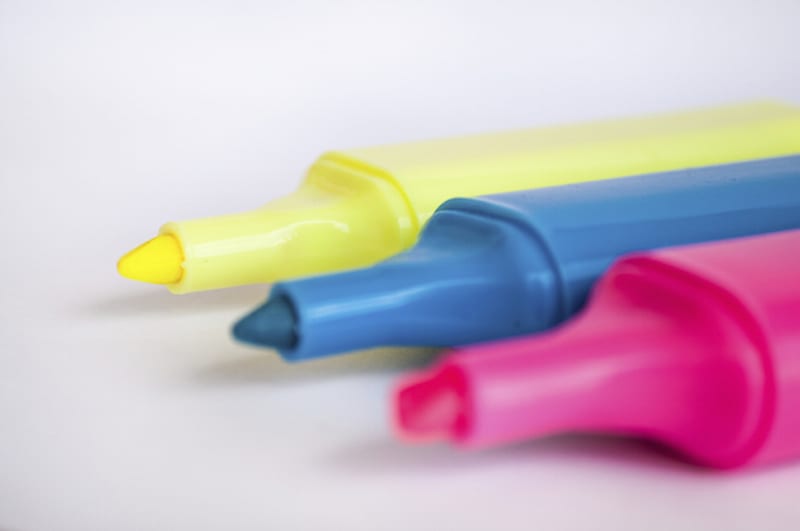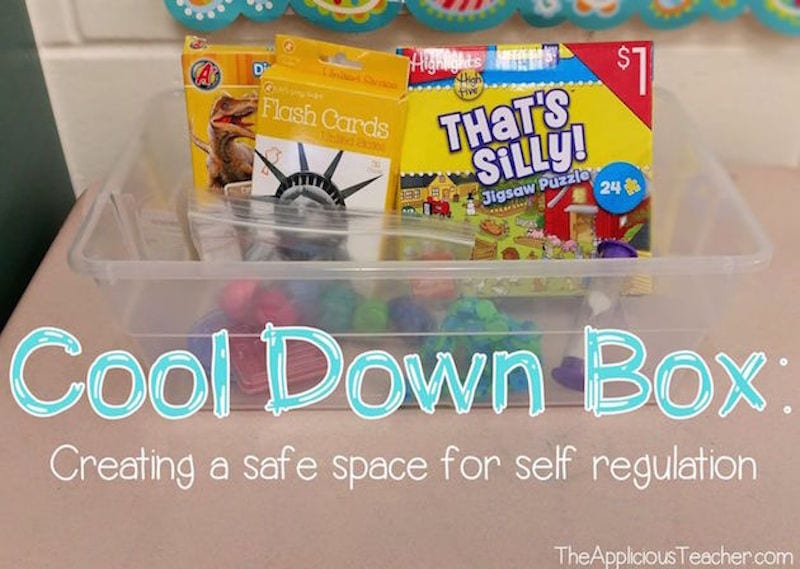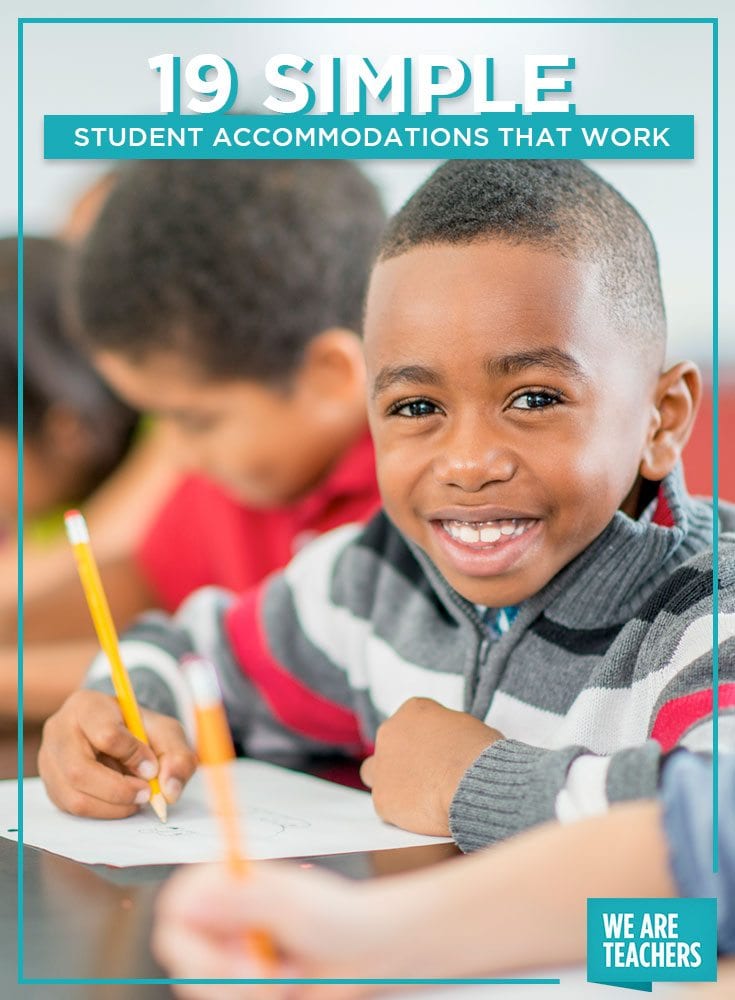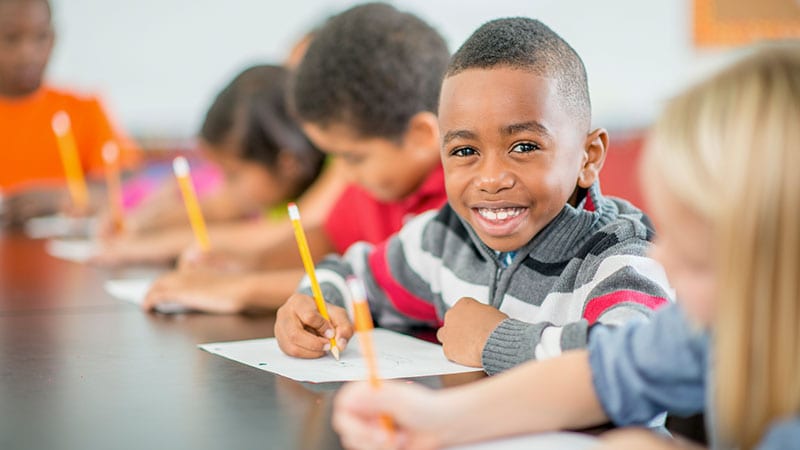Whether you have students on IEPs or you’re just looking for ways to informally help kids who are struggling in your class, here’s a big list of student accommodations, adapted from Mentoring Minds’ Accommodations Educator Wheel, that gives everyone in your class an opportunity to learn together and find success at school.
1. Begin with the end.
It can be hard for some kids to visualize what the end product of an assignment or project should look like. So whenever possible, show kids examples of the final product of the same assignment that was previously completed by former students. If that’s not possible, try modeling your own example of the assignment.
2. Partner up.
Study buddies or lab partners can help copy assignments, transcribe oral answers, or read directions aloud to help clarify directions.

3. Talk it out.
If written answers are creating a major roadblock for students, consider allowing oral responses for class work or during tests. You can also let kids make audio-recorded responses of their homework.
4. Change up your tests.
If you know a kid has a really hard time concentrating at the end of the day, but an exam is scheduled for last period, try testing the student in the morning instead. If a large classroom full of students is too distracting, let the student sit at a study carrel in your classroom. You can also let them take the exam in a different room.
5. Sing a song.
When you put a tune to important information, it often makes it easier for kids to remember. You can make up your own songs or use some that have already been written—like these math music videos about everything from skip counting to geometry.
6. Use memory tricks.
There are the classic mnemonic devices—like ROY G BIV to remember the colors of the rainbow or Please Excuse My Dear Aunt Sally to recall the order of operations when solving an equation. You can also check out this list for some other cool memory tricks to use with your class. Maybe, if you’re feeling creative, make up your own!
7. Get out your highlighter.
Highlight, italicize, or bold key words or phrases in textbooks, homework, study guides, and tests to help kids home in on the most important information. Eventually, kids may be able to highlight the text themselves before they start an assignment or exam.

8. Graph paper isn’t just for graphing.
Lots of kids have trouble keeping numbers aligned when solving math problems. Show them how to use graph paper to organize and align the numbers in the correct columns.
9. Make a list.
It can be daunting to do assignments that require multiple steps. So, help put things into perspective by numbering the steps in a task and writing them on a piece of paper that students can keep at their desks. When students cross off completed items from the list, it helps keep them on track and also provides a sense of accomplishment.
10. Bounce out your wiggles.
Some students actually have trouble concentrating if they’re required to sit still in a chair. For those kids, try letting them stand up while they’re working. If you have access to a T-stool or a balance ball, it can be used to help kids get their wiggles out and get their work done.

11. Take a brain break.
Sometimes, kids need to put academics aside for a few minutes of physical activity to get back on track with their work. Try doing some simple yoga or stretching exercises. You can also check out GoNoodle for more brain break ideas.
12. Use audiobooks.
If you have struggling readers or ELL students, audiobooks are an invaluable tool to help them find their love of reading and stay engaged. Even if your school doesn’t have a subscription to an audiobook website, there are some great free options!
13. Set up a cool-down station.
Designate a safe place where students can go to cool down or regroup when they become frustrated. This space could be a comfortable chair or a desk that’s away from the group. You can also make a cool-down box with things like puzzles, Silly Putty, or other fidget toys to help kids de-stress.

Image Credit: The Applicious Teacher
14. Write in color.
Provide different kinds and colors of paper when students are writing or taking notes. Different color pens are especially helpful for organizing thoughts when writing (e.g., red for main idea, green for details, etc.).
15. Stay close.
If you have a student who has a hard time following directions, try standing next to them when you’re giving directions, because sometimes, just being in close proximity helps the student better absorb the information.
16. Make up your own sign language.
You can avoid stopping your lesson and singling out students who need attention by coming up with pre-arranged, non-verbal signals or cues. For example, if a student needs to leave the room or has to cool off, the signal could be to raise two fingers.

17. Put fewer questions on the page.
Some students get overwhelmed and have difficulty concentrating when there are too many questions or problems on a worksheet. So, try putting only a few on each page to help them stay focused and complete the assignment.
18. Minimize noise.
Let kids wear noise-canceling headphones or earplugs while they’re completing independent work. Some kids may even benefit from listening to classical music. You can also seat students in low-traffic areas of the classroom. Therefore, there are fewer distractions while they’re trying to get their work done.
19. Make flash cards.
Flash cards aren’t only helpful for learning math facts. You can also use them for subjects like science and social studies. If you’re teaching a concept, like the lifecycle of a butterfly, try including graphics on each card to give kids an additional visual cue.
FREE E-BOOK! How to Build a 36-Week Character Education Program. Support social-emotional learning through a critical thinking lens with 36 projects and activities plus tips, research, and more!


